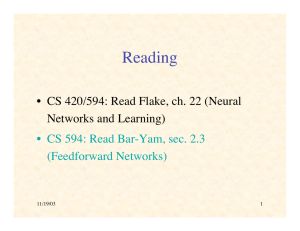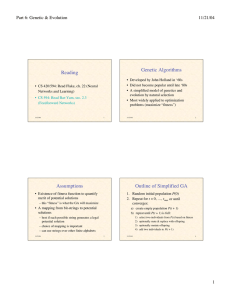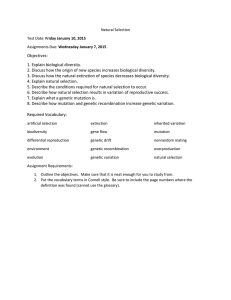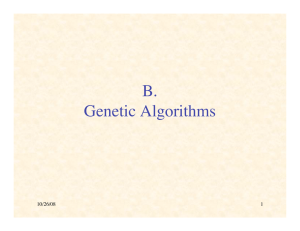Markov Chain Model and Poli Based Schema Model
advertisement
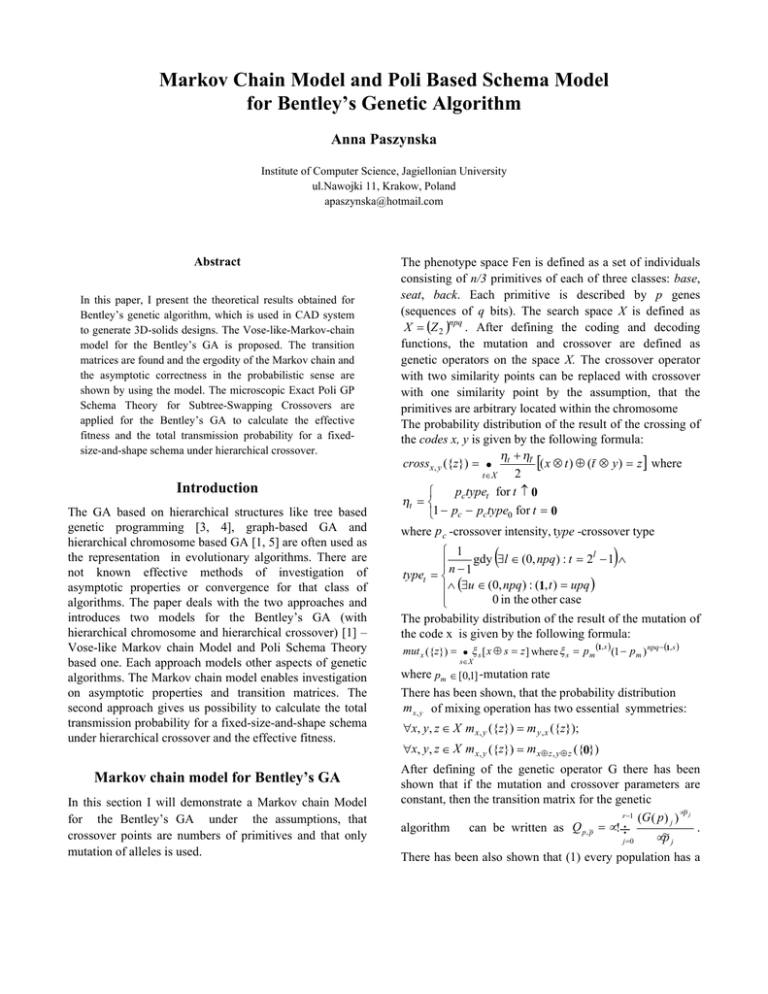
Markov Chain Model and Poli Based Schema Model
for Bentley’s Genetic Algorithm
Anna Paszynska
Institute of Computer Science, Jagiellonian University
ul.Nawojki 11, Krakow, Poland
apaszynska@hotmail.com
Abstract
In this paper, I present the theoretical results obtained for
Bentley’s genetic algorithm, which is used in CAD system
to generate 3D-solids designs. The Vose-like-Markov-chain
model for the Bentley’s GA is proposed. The transition
matrices are found and the ergodity of the Markov chain and
the asymptotic correctness in the probabilistic sense are
shown by using the model. The microscopic Exact Poli GP
Schema Theory for Subtree-Swapping Crossovers are
applied for the Bentley’s GA to calculate the effective
fitness and the total transmission probability for a fixedsize-and-shape schema under hierarchical crossover.
Introduction
The GA based on hierarchical structures like tree based
genetic programming [3, 4], graph-based GA and
hierarchical chromosome based GA [1, 5] are often used as
the representation in evolutionary algorithms. There are
not known effective methods of investigation of
asymptotic properties or convergence for that class of
algorithms. The paper deals with the two approaches and
introduces two models for the Bentley’s GA (with
hierarchical chromosome and hierarchical crossover) [1] –
Vose-like Markov chain Model and Poli Schema Theory
based one. Each approach models other aspects of genetic
algorithms. The Markov chain model enables investigation
on asymptotic properties and transition matrices. The
second approach gives us possibility to calculate the total
transmission probability for a fixed-size-and-shape schema
under hierarchical crossover and the effective fitness.
Markov chain model for Bentley’s GA
In this section I will demonstrate a Markov chain Model
for the Bentley’s GA under the assumptions, that
crossover points are numbers of primitives and that only
mutation of alleles is used.
The phenotype space Fen is defined as a set of individuals
consisting of n/3 primitives of each of three classes: base,
seat, back. Each primitive is described by p genes
(sequences of q bits). The search space X is defined as
X = (Z 2 )npq . After defining the coding and decoding
functions, the mutation and crossover are defined as
genetic operators on the space X. The crossover operator
with two similarity points can be replaced with crossover
with one similarity point by the assumption, that the
primitives are arbitrary located within the chromosome
The probability distribution of the result of the crossing of
the codes x, y is given by the following formula:
η + ηt
crossx, y ({z}) = ∑ t
[( x ⊗ t ) ⊕ (t ⊗ y) = z ] where
2
t∈X
pctypet for t ≠ 0
ηt =
1 − pc − pctype0 for t = 0
where p c -crossover intensity, type -crossover type
(
)
1
gdy ∃l ∈ (0, npq ) : t = 2l − 1 ∧
n − 1
typet =
∧ (∃u ∈ (0, npq) : (1, t ) = upq )
0 in the other case
The probability distribution of the result of the mutation of
the code x is given by the following formula:
mut x ({z}) = ∑ ξ s [ x ⊕ s = z ] where ξ s = p m (1, s ) (1 − p m ) npq −(1, s )
s∈ X
where pm ∈ [0,1] -mutation rate
There has been shown, that the probability distribution
m x , y of mixing operation has two essential symmetries:
∀x, y, z ∈ X m x, y ({z}) = m y , x ({z});
∀x, y, z ∈ X m x, y ({z}) = m x ⊕ z , y ⊕ z ({0})
After defining of the genetic operator G there has been
shown that if the mutation and crossover parameters are
constant, then the transition matrix for the genetic
~
r −1 (G ( p ) ) µp j
j
algorithm
can be written as Q p , ~p = µ!∏
.
µ~p
j =0
j
There has been also shown that (1) every population has a
nonzero probability of being the next generation and (2)
the transition matrix Qx, is strongly positive definite.
From 2 it follows, that the Markov chain describing the
dynamics of the genetic algorithm is ergodic. From the
Ergodic Theorem it follows that
• for the arbitrary started probability measure π µ0 on X µ
α ( H , t ) = (1 − p x0 ) p ( H , t ) + p x0 ∑ ∑ p (h1 , t ) p (h2 , t ) *
h1 h2
∑ ∑ p (i, j | h1 , h2 ) * [h1 ∈ U ( H , i )][h2 ∈ L( H , i, j )]
i∈H j
where all the variables are defined as in [3].
The effective fitness for fixed size and shape schema F
with hierarchical crossover and without mutation is:
exists π µ : lim π µt = lim Q tπ µ0 = π µ
f eff ( H , t ) =
• the GA is asymptotically correct in the probabilistic
sense.
(1 − px0 ) p( H , t ) + px0 ∑ ∑ p(h1 , t ) p(h2 , t ) ∑∑ p(i, j | h1 , h2 )
h1 h2
i∈H j
[h1 ∈ U ( H , i )][h2 ∈ L( H , i, j )]
t → +∞
t → +∞
Exact Microscopic Schema Theory for
Bentley’s GA
Theoretical results presented below are obtained on the
basis of Microscopic Schema Theory for GP with subtreeSwapping Crossover, introduced in [3]. Hierarchical
crossover used in Bentley’s GA is modeled as strongly
typed crossover described by D.J.Montana in [2]. To
describe hierarchical crossover by means of strongly typed
crossover, I have to reorganize the hierarchical
chromosome structure in the following way:
Figure 1. Reorganizing of the hierarchical chromosome
A node in the tree is coded in the Node Reference System
as a pair (d,i), where d is the layer number and i denotes
node index in the layer. The following definitions defines a
function other the node reference system:
• The function IB(d,i) returning 1 if the node with
coordinates (d,i) is a bit and 0 in the other case
• C(d,i,h) returning a class of the node with coordinates
(d,i) in the tree with root h
• Function CM returning 1 when nodes are in the same
class and 0 in the other case.
For hierarchical crossover probability of choosing nodes
with coordinates (d1 , i1 ), (d 2 , i2 ) in h1 , h2 respectively equals:
p scgp (d1 , i1 , d 2 , i2 | h1 , h2 ) =
CM (d1 , i1 , d 2 , i2 , h1 , h2 )
max_ depth ( h1 ) max_ depth ( h2 ) pq pq
∑
D1 = 0
∑
D2 = 0
∑ ∑ CM ( D1 , I1 , D2 , I 2 , h1 , h2 )
I1 = 0 I 2 = 0
A variable arity hyperschema is defined as in [3].The only
one difference is that the function set F and the terminal set
T are defined as: F={base,seat,back}; T={0,1}. The total
transmission probability for a fixed-size-and-shape schema
H under hierarchical crossover and no mutation is :
f (H ,t)
*
p( H , t )
Conclusions
In the paper, I have presented theoretical results obtained
for Bentley’s GA, which has been used in CAD system to
generate 3D-solids designs. To model several aspects of
the genetic algorithm, two approaches has been used.
Firstly, the Vose-like-Markov-chain model for Bentley’s
GA has been introduced. This theoretical approach
provides an excellent framework for studying the dynamics
of genetic algorithms based on hierarchical structures.
Presented model has been used for finding the transition
matrices and for investigation of asymptotic properties by
using the Markov transition functions. The ergodity of the
Markov chain describing the Bentley’s GA has also been
shown. Secondly, the microscopic Exact Poli GP Schema
Theory for Subtree-Swapping Crossovers has been applied
to Bentley’s GA to calculate the effective fitness and the
total transmission probability for the fixed-size-and-shape
schema.
References
1. Bentley, P.J. 1997. Genetic Evolutionary Design of
Solid Objects using a Genetic Algorithm, Ph.D.diss,
UCL London.
2. Montana, D.J. 1995. Strongly typed genetic
programming. Evolutionary Computation. 3(2):199230.
3. Poli, R. 2001. General Schema Theory for Genetic
Programming with subtree-Swapping Crossover,
Genetic Programming. In Proceedings of EuroGP,
LNCS, (Milan):Springer-Verlag.
4. Poli, R.; Rove, J.E.; McPhee, N.F. 2001. Markov Chain
Models for GP and variable-length Gas with
Homologous Crossover , In Proceedings of the
Genetic and Evolutionary Computation Conference.
San Francisco, Calif.: Morgan Kaufmann.
5. Schaefer, R.; Ko•odziej, J.; Paszynska, A. 2004.
Hierarchical genetic computations in optimal design. A
Journal of Theoretical and Applied Mechanics.
3(42):519-538.
6. Vose, M.D. 1999. The simple genetic algorithm, MIT
Press.

